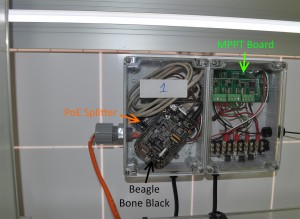A Stochastic Approach to Asynchronous Differential Power Processing for True Maximum Power Point Tracking of Photovoltaic Sub-modules
A Stochastic Approach to Asynchronous Differential Power Processing for True Maximum Power Point Tracking of Photovoltaic Sub-modules
MSEE student Felix Z. Hsiao with adviser R. Pilawa-Podgurski
Modules and sub-modules must be biased at the correct voltages and currents in order to extract the maximum power from photovoltaic (PV) systems. Since these operating points change dynamically with factors such as insolation, shading, temperature, and panel age, it is necessary for power converters to actively perform maximum power point tracking (MPPT). In differential power processing (DPP), only the differences in powers of adjacent PV modules/sub-modules are processed, rather than the full power of the system. As the power converters are processing less power, there is less loss, and thus overall efficiency increases. For large PV systems, requiring communication can cause significant delays in the MPPT process, as the information must traverse the entire system. By introducing a stochastic process of idling times, it is possible for DPP converters to perform MPPT asynchronously, with minimal chance of interference. Simulation of a 4-panel system demonstrated a steady-state tracking efficiency of over 99.8%.
A prototype board was designed. Test results suggested that a revised power-stage layout was necessary. A second board revision has been designed and manufactured. The updated version features shorter trace lengths, smaller board size, and the use of daughter boards, which provide greater flexibility and survivability of the mother board. Before testing the new board, it is desired to have a robust, long-term solution for mounting and data acquisition from an array of 12 PV panels. A previous, working design will be tested in this system. For communication, we will use Beagle Bone Blacks, which are miniature Linux computers, to talk to the boards over I2C. Power and data will be transferred using power over Ethernet (PoE), as shown in Figure 1, The complete system will be able to gather voltage, current, and power data from the array, as well as turn on/off MPPT to measure improved performance.
This project is funded in part by the Advanced Research Projects Agency-Energy (ARPA-E), U.S. Department of Energy, under Award Number DE-AR0000217.
